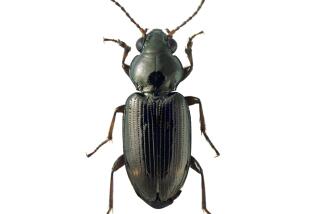Creepy Companions
- Share via
OXNARD — James Fujita’s house is bursting with bugs and critters. There are the giant millipede and the hissing cockroach. The banded gecko and the alligator lizard. The bird-eating tarantula and the emperor scorpion.
Nearly 10,000 in all. Some alive, most dead, they are all over the living room, the kitchen, the garage--in boxes, bags, jars or under glass.
“From the shower to the freezer, they are everywhere,” said David Fujita, James’ father. “They are even in the closet.”
Though he is only 18 years old, James Fujita is a renowned entomologist, respected for his collection of rare bugs and his knowledge about insect anatomy and preservation.
Fujita started sharing his love of bugs when he was a first-grader. That is when he gave his first classroom speech. Since then, Fujita has made presentations at museums, to community groups and in more than 500 classes in nine school districts.
These days teachers have to call Fujita, a senior at Rio Mesa High School, a year in advance to book a presentation.
Among his accomplishments, Fujita is credited with discovering a new species of Jerusalem cricket and catching the first mutant white monarch butterfly in Hawaii. He has helped local farmers identify insects and has documented insects for various Nature Conservancy preserves throughout the state.
The talkative teen, whose hair falls on his face, began his fascination with bugs when he was 3 years old after he caught his first butterfly in the yard and put it in a jar. A short time later, David Fujita remembers, his son threw aside his teddy bears and blankets in favor of a small yellow book about insects.
One of young Fujita’s first toys was a net made of a badminton racket and an old piece of fabric.
Now his room is full of trophies, plaques and bug paraphernalia. Paper butterflies hang from the ceiling. The bookshelves are lined with volumes such as The Insect Almanac and The Encyclopedia of Butterflies. And his dresser is home for his frog, Kermit, and his pet snakes, Monty Python and Julius Squeezer.
*
Fujita’s favorite bugs? The ones that look like walking sticks and leaves--elongated insects that remain motionless and look like grass stems and twigs. They just look really neat, he said.
The most valuable? The white monarch butterfly.
His most exciting find? An elephant beetle in the Costa Rican rain forest. He found it on a hot, humid morning while he was out on a daily hunt. He was anxious, excited, unsure of what he would find. He looked carefully at a banana tree and saw the beetle clinging to its trunk.
“I learned the hard way that they have the sharpest claws,” he said. “I couldn’t pry it off the tree. And when I finally did, it absolutely shredded one of the nets.”
Fujita’s interest in bugs was contagious. Both his parents have become mini-experts on the subject and often get just as excited about bug finds as James.
“It changed the way we take trips,” said his mother, Carol Fujita. “My idea of a vacation was staying in a nice hotel room. Then, all of a sudden we were in tents looking for bugs.”
The Fujitas have visited Hawaii, Costa Rica, Japan and Thailand on bug-hunting expeditions. Everywhere he went, James Fujita carried his nets, jars and envelopes. And he was always on the lookout for exotic insects.
“When you are looking for bugs, you have to look everywhere, even in the grocery store,” he said. “You never know when you are going to find them.”
In Hawaii, David Fujita said, his son came running into the restaurant of their fancy hotel holding a large cockroach he had found in the bathroom. Though the rest of the hotel patrons were disgusted, James Fujita was delighted. That same trip, he ran for a mile, through people’s lawns and over their fences to catch a rare white monarch butterfly.
In Costa Rica, an owl butterfly flew into the Chinese restaurant where he and his parents were eating.
“Traveling is one of the best parts,” James Fujita said. “Seeing places and insects you’ve only read about in books and magazines is in a league of its own.”
The next trip he wants to take is to South America.
The teen’s resume is stacked: When he was 12, he was chosen Young Entomologist of the Year by the Los Angeles chapter of the international Lorquin Entomological Society. That same year, he showcased his insects on “The Tonight Show With Jay Leno.”
When he was 14, he was one of six students nationwide selected for the Kids’ Hall of Fame, and received a $10,000 college scholarship.
He has worked with the Insect Zoo of the Los Angeles County Natural History Museum, and he has documented insects for the states of California and Arizona.
Fujita is also interested in paint ball, computer games, body boarding and swimming. And he is an honors students who has won numerous academic honors and awards.
*
Carol Fujita said studying entomology has taught James to think on his feet, to be comfortable speaking in front of groups and to learn about people who are different from him. In addition to speaking to Boy Scout groups and college students, Fujita has made presentations to senior citizens and mentally and physically challenged youths.
And four years ago, he fulfilled the wish of a terminally-ill Japanese girl. The 8-year-old, Takae Tsuchida, was as much of a fan of bugs as Fujita. So when the Make-A-Wish Foundation asked her what she wished for most in the world, she said she wanted to meet James Fujita and see his collection of bugs. Takae died a few months after their visit.
Now, Fujita is finishing up his senior year and preparing to attend USC, where he received a full-tuition scholarship. Fujita has also received many other scholarships because of his interest in entomology and his desire to share that knowledge.
Fujita said he hasn’t decided on his major, or whether he wants to work professionally as an entomologist. But he doesn’t think he will ever stop collecting and studying bugs.
“I’m actually pretty ignorant about bugs,” he said. “There’s so much I don’t know.”
More to Read
Sign up for The Wild
We’ll help you find the best places to hike, bike and run, as well as the perfect silent spots for meditation and yoga.
You may occasionally receive promotional content from the Los Angeles Times.






